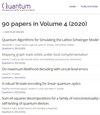Reinforcement Learning Based Quantum Circuit Optimization via ZX-Calculus
IF 5.1
2区 物理与天体物理
Q1 PHYSICS, MULTIDISCIPLINARY
引用次数: 0
Abstract
We propose a novel Reinforcement Learning (RL) method for optimizing quantum circuits using graph-theoretic simplification rules of ZX-diagrams. The agent, trained using the Proximal Policy Optimization (PPO) algorithm, employs Graph Neural Networks to approximate the policy and value functions. We demonstrate the capacity of our approach by comparing it against the best performing ZX-Calculus-based algorithm for the problem in hand. After training on small Clifford+T circuits of 5-qubits and few tenths of gates, the agent consistently improves the state-of-the-art for this type of circuits, for at least up to 80-qubit and 2100 gates, whilst remaining competitive in terms of computational performance. Additionally, we illustrate the versatility of the agent by incorporating additional optimization routines on the workflow during training, improving the two-qubit gate count state-of-the-art on multiple structured quantum circuits for relevant applications of much larger dimension and different gate distributions than the circuits the agent trains on. This conveys the potential of tailoring the reward function to the specific characteristics of each application and hardware backend. Our approach is a valuable tool for the implementation of quantum algorithms in the near-term intermediate-scale range (NISQ).基于zx -微积分的强化学习量子电路优化
我们提出了一种新的强化学习(RL)方法,利用zx图的图论简化规则来优化量子电路。该智能体使用近端策略优化(PPO)算法进行训练,并使用图神经网络来近似策略和值函数。我们通过将我们的方法与针对手头问题的性能最好的基于zx - calculus的算法进行比较来证明我们的方法的能力。在5个量子位和几个门的小Clifford+T电路上训练后,智能体不断提高这类电路的技术水平,至少达到80个量子位和2100个门,同时在计算性能方面保持竞争力。此外,我们通过在训练过程中在工作流程中加入额外的优化例程来说明智能体的多功能性,在多个结构化量子电路上改进了双量子比特门计数的最新技术,以适应比智能体训练的电路更大的维度和不同的门分布的相关应用。这传达了根据每个应用程序和硬件后端的特定特征定制奖励函数的潜力。我们的方法是在近期的中等规模范围(NISQ)中实现量子算法的有价值的工具。
本文章由计算机程序翻译,如有差异,请以英文原文为准。
求助全文
约1分钟内获得全文
求助全文
来源期刊

Quantum
Physics and Astronomy-Physics and Astronomy (miscellaneous)
CiteScore
9.20
自引率
10.90%
发文量
241
审稿时长
16 weeks
期刊介绍:
Quantum is an open-access peer-reviewed journal for quantum science and related fields. Quantum is non-profit and community-run: an effort by researchers and for researchers to make science more open and publishing more transparent and efficient.
 求助内容:
求助内容: 应助结果提醒方式:
应助结果提醒方式:


